Middleton W.M. (ed.) Reference Data for Engineers: Radio, Electronics, Computer and Communications
Подождите немного. Документ загружается.

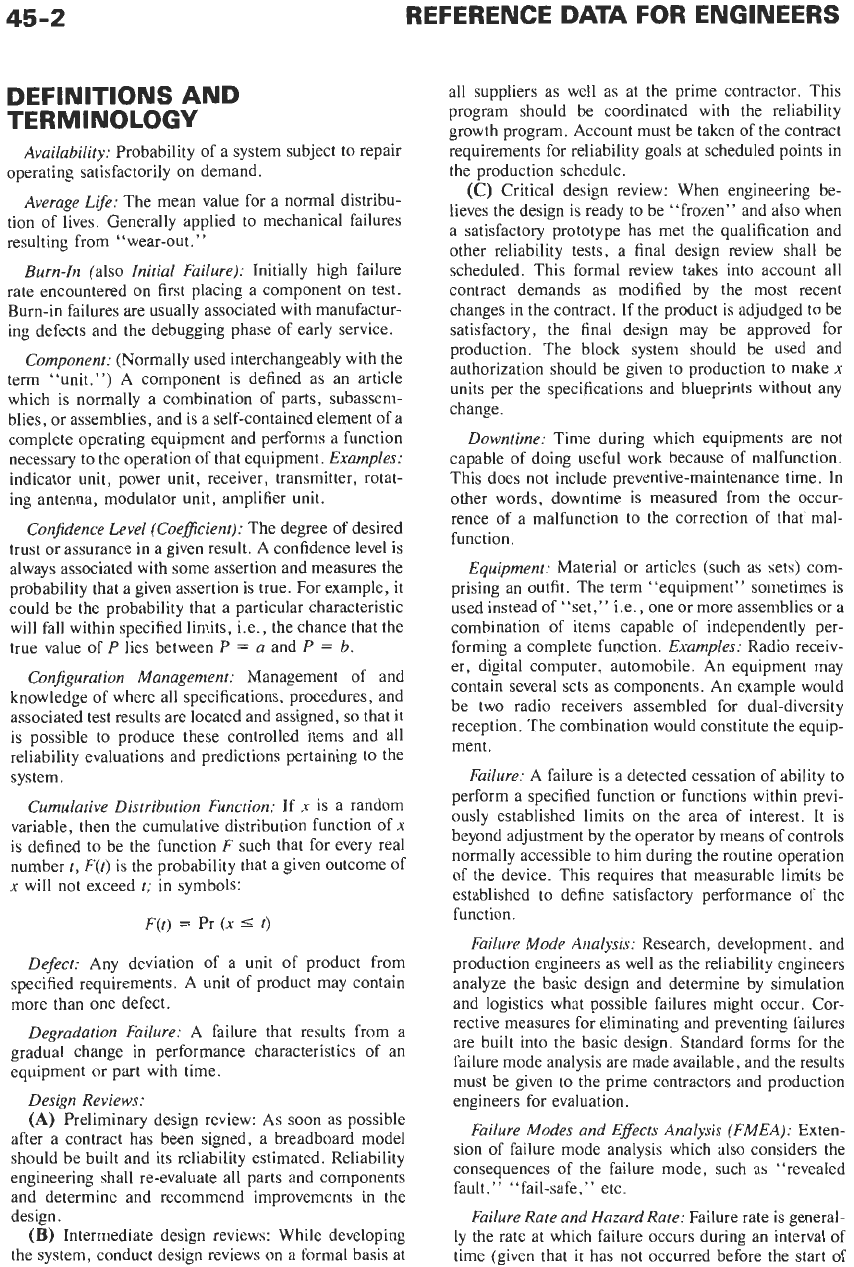
45-2
REFERENCE DATA
FOR
ENGINEERS
DEFINITtONS
AND
TERMINOLOGY
Availability:
Probability of a system subject to repair
operating satisfactorily
on
demand.
Average Life:
The mean value for a normal distribu-
tion of lives. Generally applied to mechanical failures
resulting from “wear-out.”
Burn-In
(also
Initial Failure):
Initially high failure
rate encountered
on
first placing a component
on
test.
Burn-in failures are usually associated with manufactur-
ing defects and the debugging phase of early service.
Component:
(Normally used interchangeably with the
term “unit.”) A component is defined as an article
which is normally a combination
of parts, subassem-
blies, or assemblies, and is a self-contained element of a
complete operating equipment and performs a function
necessary to the operation of that equipment.
Examples:
indicator unit, power unit, receiver, transmitter, rotat-
ing antenna, modulator unit, amplifier unit.
Confidence Level (Coeficient):
The degree of desired
trust or assurance in a given result. A confidence level is
always associated with some assertion and measures the
probability that a given assertion is true. For example, it
could be the probability that a particular characteristic
will fall within specified limits, i.e., the chance that the
true value of
P
lies between
P
=
a
and
P
=
b.
Configuration Management:
Management of and
knowledge of where all specifications, procedures, and
associated test results are located and assigned,
so
that it
is possible to produce these controlled items and all
reliability evaluations and predictions pertaining to the
system.
Cumulative Distribution Function:
If
x
is a random
variable, then the cumulative distribution function of
x
is defined to be the function
F
such that for every real
number
t,
F(t)
is the probability that a given outcome of
x
will
not
exceed t; in symbols:
F(t)
=
Pr
(x
5
t)
Defect:
Any deviation of a unit of product from
specified requirements.
A
unit of product may contain
more than one defect.
Degradation Failure:
A
failure that results from a
gradual change
in
performance characteristics of an
equipment or part with time.
Design Reviews:
(A)
Preliminary design review: As
soon
as possible
after a contract has been signed, a breadboard model
should be built and its reliability estimated. Reliability
engineering shall re-evaluate all parts and components
and determine and recommend improvements in the
design.
(€5)
Intermediate design reviews: While developing
the system, conduct design reviews
on
a formal basis at
all suppliers as well as at the prime contractor. This
program should be coordinated with the reliability
growth program. Account must be taken of the contract
requirements for reliability goals at scheduled points in
the production schedule.
(C) Critical design review: When engineering be-
lieves the design is ready to be “frozen” and also when
a satisfactory prototype has met the qualification and
other reliability tests, a final design review shall be
scheduled. This formal review takes into account all
contract demands as modified by the most recent
changes in the contract. If the product is adjudged to be
satisfactory, the final design may be approved for
production. The block system should be used and
authorization should be given to production to make
x
units per the specifications and blueprints without any
change.
Downtime:
Time during which equipments are not
capable of doing useful work because of malfunction.
This does not include preventive-maintenance time.
In
other words, downtime is measured from the occur-
rence
of
a malfunction to the correction of that mal-
function.
Equipment:
Material or articles (such as sets) com-
prising an outfit. The term “equipment” sometimes is
used instead of “set,” i.e., one or more assemblies or a
combination of items capable of independently per-
forming a complete function.
Examples:
Radio receiv-
er, digital computer, automobile. An equipment may
contain several sets as components. An example would
be two radio receivers assembled for dual-diversity
reception. The combination would constitute the equip-
ment.
Failure:
A failure is a detected cessation of ability to
perform a specified function
or
functions within previ-
ously established limits
on
the area of interest. It is
beyond adjustment by the operator by means of controls
normally accessible to him during the routine operation
of the device. This requires that measurable limits be
established to define satisfactory performance
of
the
function.
Failure Mode Analysis:
Research, development, and
production engineers as well as the reliability engineers
analyze the basic design and determine by simulation
and logistics what possible failures might occur. Cor-
rective measures for eliminating and preventing failures
are built into the basic design. Standard forms for the
failure mode analysis are made available, and the results
must be given to the prime contractors and production
engineers for evaluation.
Failure Modes and Effects Analysis (FMEA):
Exten-
sion of failure mode analysis which also considers the
consequences of the failure mode, such
a5
“revealed
fault
,”
“fail-safe,
”
etc.
Failure Rate and Hazard Rate:
Failure rate is general-
ly
the rate at which failure occurs during an interval of
time (given that it has not occurred before the start of
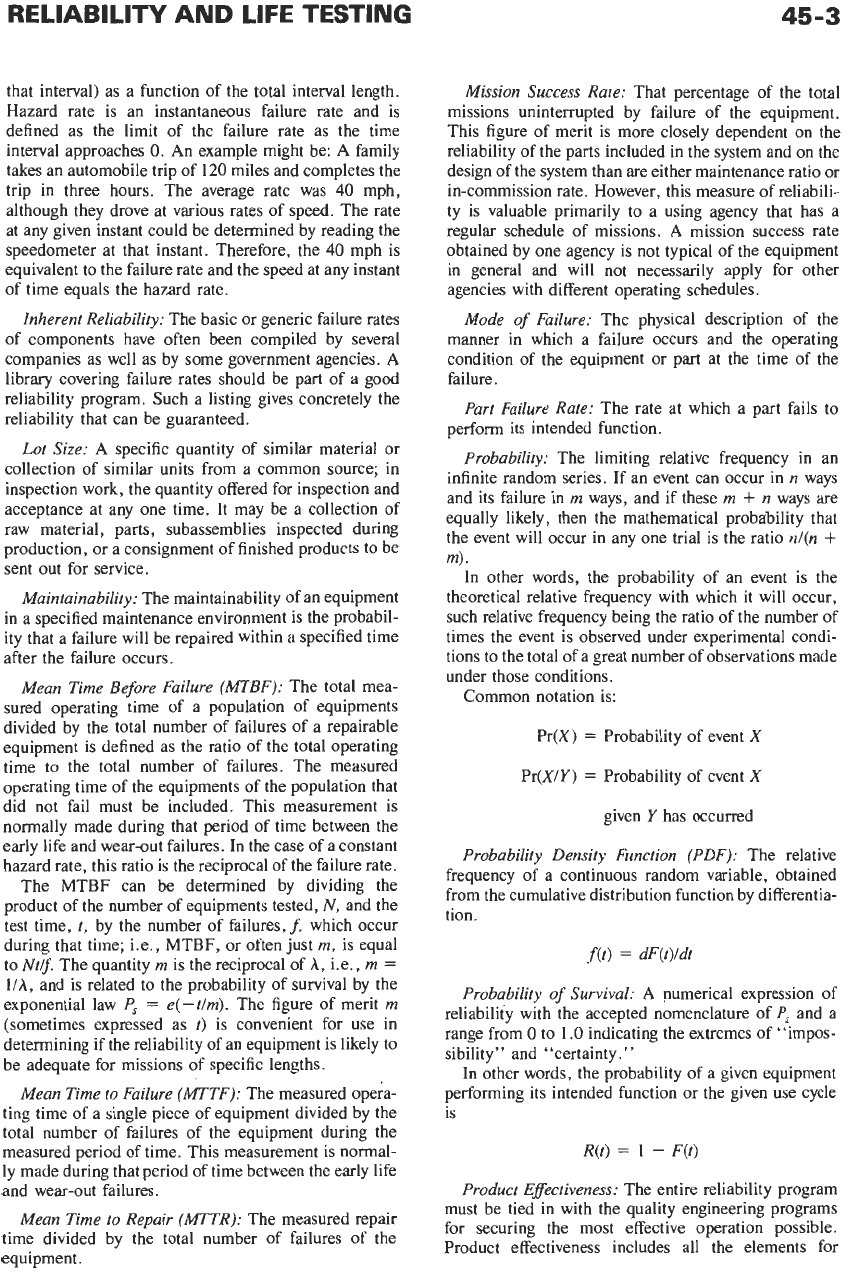
RELIABILITY AND LIFE TESTING
45-3
that interval) as a function of the total interval length.
Hazard rate is an instantaneous failure rate and is
defined as the limit of the failure rate as the time
interval approaches
0.
An example might be: A family
takes an automobile trip of
120
miles and completes the
trip in three hours. The average rate was
40
mph,
although they drove at various rates of speed. The rate
at any given instant could be determined by reading the
speedometer at that instant. Therefore, the
40
mph is
equivalent to the failure rate and the speed at any instant
of time equals the hazard rate.
Inherent Reliability:
The basic or generic failure rates
of components have often been compiled by several
companies as well as by some government agencies.
A
library covering failure rates should be part of a good
reliability program. Such a listing gives concretely the
reliability that can be guaranteed.
Lot Size:
A
specific quantity of similar material or
collection of similar units from a common source; in
inspection work, the quantity offered for inspection and
acceptance at any one time. It may be a collection of
raw material, parts, subassemblies inspected during
production, or a consignment of finished products to be
sent out for service.
Maintainability:
The maintainability of an equipment
in a specified maintenance environment is the probabil-
ity that a failure will be repaired within a specified time
after the failure occurs.
Mean Time Before Failure (MBF):
The total mea-
sured operating time of a population of equipments
divided by the total number of failures of a repairable
equipment is defined as the ratio of the total operating
time to the total number of failures. The measured
operating time of the equipments of the population that
did not fail must be included. This measurement is
normally made during that period of time between the
early life and wear-out failures. In the case of a constant
hazard rate, this ratio is the reciprocal of the failure rate.
The MTBF can be determined by dividing the
product of the number of equipments tested,
N,
and the
test time,
t,
by the number of failures,
f,
which occur
during that time; i.e., MTBF, or often just
m,
is equal
to
Ntlf.
The quantity
m
is the reciprocal of
A,
Le.,
m
=
l/A,
and is related to the probability of survival by the
exponential law
P,
=
e(-t/m).
The figure of merit
m
(sometimes expressed as
t)
is convenient for use in
determining if the reliability of an equipment is likely to
be adequate for missions of specific lengths.
Mean Time to Failure (MTTF):
The measured opera-
ting time of a single piece of equipment divided by the
total number of failures of the equipment during the
measured period of time. This measurement is normal-
ly made during that period of time between the early life
and wear-out failures.
Mean Time
to
Repair (MTTR):
The measured repair
time divided by the total number of failures of the
equipment.
Mission Success Rate:
That percentage of the total
missions uninterrupted by failure of the equipment.
This figure of merit is more closely dependent on the
reliability of the parts included in the system and on the
design of the system than are either maintenance ratio or
in-commission rate. However, this measure of reliabili-
ty is valuable primarily to a using agency that has a
regular schedule of missions.
A
mission success rate
obtained by one agency is not typical of the equipment
in general and will not necessarily apply for other
agencies with different operating schedules.
Mode of Failure:
The physical description of the
manner in which a failure occurs and the operating
condition of the equipment or part at the time of the
failure.
Part Failure Rate:
The rate at which a part fails to
perform its intended function.
Probability:
The limiting relative frequency in an
infinite random series. If an event can occur in
n
ways
and its failure in
m
ways, and if these
m
+
n
ways are
equally likely, then the mathematical probability that
the event will occur in any one trial is the ratio
nl(n
+
4.
In other words, the probability of an event is the
theoretical relative frequency with which it will occur,
such relative frequency being the ratio of the number of
times the event is observed under experimental condi-
tions to the total of a great number of observations made
under those conditions.
Common notation is:
Pr(X)
=
Probability of event X
Pr(X/Y)
=
Probability of event X
given
Y
has occurred
Probability Density Function (PDF):
The relative
frequency of a continuous random variable, obtained
from the cumulative distribution function by differentia-
tion.
f(t)
=
dF(t)/dt
Probability of Survival:
A
numerical expression of
reliability with the accepted nomenclature of
P,
and a
range from
0
to
1
.O
indicating the extremes of “impos-
sibility” and “certainty.”
In
other words, the probability of a given equipment
performing its intended function or the given use cycle
is
R(t)
=
1
-
F(t)
Product Effectiveness:
The entire reliability program
must be tied in with the quality engineering programs
for securing the most effective operation possible.
Product effectiveness includes all the elements for
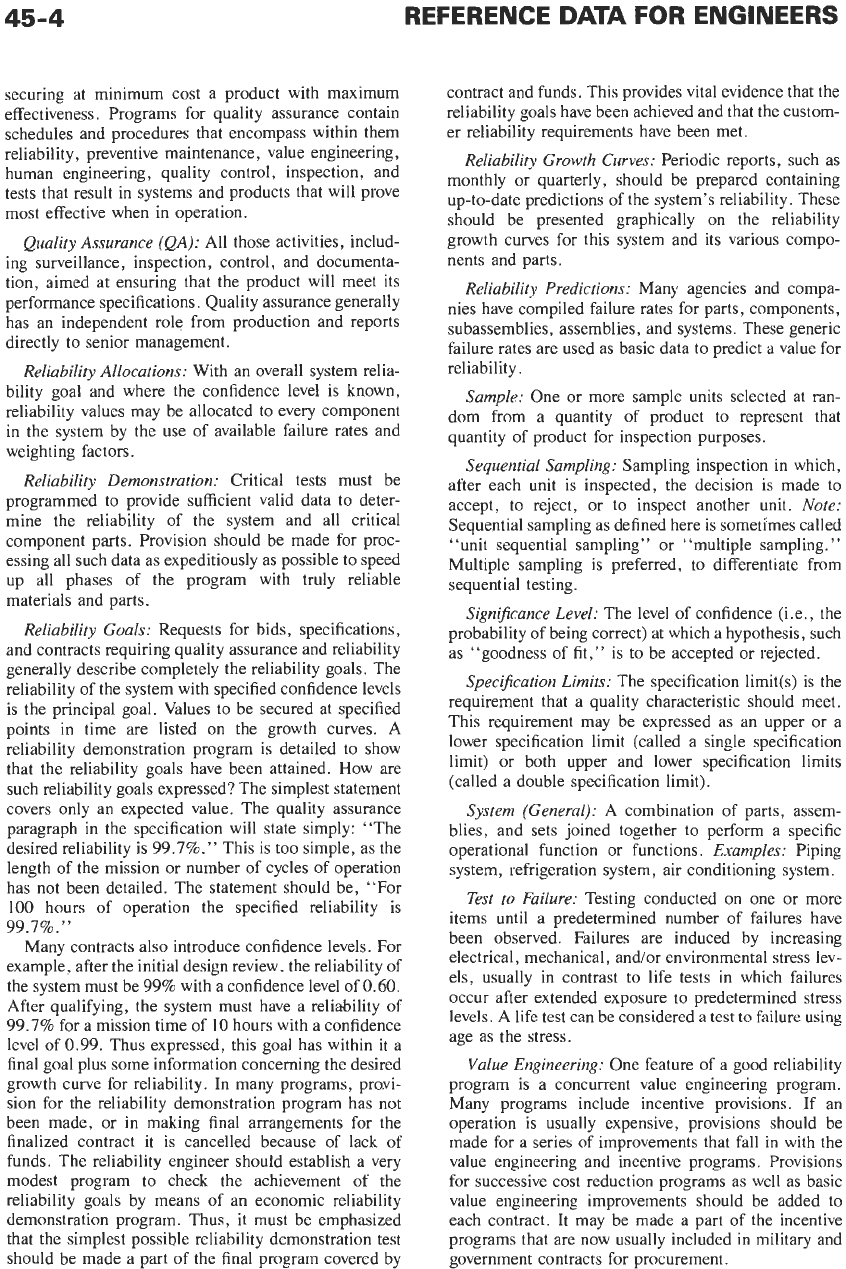
45-4
REFERENCE
DATA
FOR ENGINEERS
securing at minimum cost a product with maximum
effectiveness. Programs for quality assurance contain
schedules and procedures that encompass within them
reliability, preventive maintenance, value engineering,
human engineering, quality control, inspection, and
tests that result in systems and products that will prove
most effective when in operation.
Quality Assurance (QA):
All those activities, includ-
ing surveillance, inspection, control, and documenta-
tion, aimed at ensuring that the product will meet its
performance specifications, Quality assurance generally
has an independent role from production and reports
directly to senior management.
Reliability Allocations:
With an overall system relia-
bility goal and where the confidence level is known,
reliability values may be allocated to every component
in the system by the use of available failure rates and
weighting factors.
Reliability Demonstration:
Critical tests must be
programmed to provide sufficient valid data to deter-
mine the reliability
of the system and all critical
component parts. Provision should be made for proc-
essing all such data as expeditiously as possible
to
speed
up all phases of the program with truly reliable
materials and parts.
Reliability Goals:
Requests for bids, specifications,
and contracts requiring quality assurance and reliability
generally describe completely the reliability goals. The
reliability of the system with specified confidence levels
is the principal goal. Values to be secured at specified
points in time are listed
on
the growth curves. A
reliability demonstration program is detailed to show
that the reliability goals have been attained. How are
such reliability goals expressed? The simplest statement
covers only an expected value. The quality assurance
paragraph
in
the specification will state simply: “The
desired reliability is 99.7%.” This is too simple, as the
length of the mission or number of cycles of operation
has not been detailed. The statement should be, “For
100
hours of operation the specified reliability is
99.7%.”
Many contracts also introduce confidence levels. For
example, after the initial design review, the reliability of
the system must be 99% with a confidence level of
0.60.
After qualifying, the system must have a reliability of
99.7% for a mission time of
10
hours with a confidence
level of 0.99. Thus expressed, this goal has within it a
final goal plus some information concerning the desired
growth curve
for reliability.
In
many programs, pros+
sion for the reliability demonstration program has not
been made, or in making final arrangements for the
finalized contract it is cancelled because
of
lack of
funds. The reliability engineer should establish a very
modest program to check the achievement of the
reliability goals by means of an economic reliability
demonstration program. Thus, it must be emphasized
that the simplest possible reliability demonstration test
should be made a part of the final program covered by
contract and funds. This provides vital evidence that the
reliability goals have been achieved and that the custom-
er reliability requirements have been met.
Reliability Growth Curves:
Periodic reports, such as
monthly or quarterly, should be prepared containing
up-to-date predictions of the system’s reliability. These
should be presented graphically
on
the reliability
growth curves for this system and its various compo-
nents and parts.
Reliability Predictions:
Many agencies and compa-
nies have compiled failure rates for parts, components,
subassemblies, assemblies, and systems. These generic
failure rates are used as basic data to predict a value for
reliability.
Sample:
One or more sample units selected at ran-
dom from a quantity of product to represent that
quantity of product for inspection purposes.
Sequential Sampling:
Sampling inspection in which,
after each unit is inspected, the decision is made to
accept, to reject, or to inspect another unit.
Note:
Sequential sampling as defined here is sometimes called
“unit sequential sampling” or “multiple sampling.”
Multiple sampling is preferred, to differentiate from
sequential testing.
SigniJicance Level:
The level of confidence (i.e., the
probability of being correct) at which a hypothesis, such
as “goodness of fit,” is to be accepted or rejected.
SpeciJication Limits:
The specification limit(s) is the
requirement that a quality characteristic should meet.
This requirement may be expressed as an upper or a
lower specification limit (called a single specification
limit) or both upper and lower specification limits
(called a double specification limit).
System (General):
A combination of parts, assem-
blies, and sets joined together to perform a specific
operational function or functions.
Examples:
Piping
system, refrigeration system, air conditioning system.
Test
to
Failure:
Testing conducted
on
one or more
items until a predetermined number of failures have
been observed. Failures are induced by increasing
electrical, mechanical, and/or environmental stress lev-
els, usually in contrast to life tests in which failures
occur after extended exposure to predetermined stress
levels.
A
life test can be considered a test to failure using
age as the stress.
Value Engineering:
One feature of a good reliability
program is a concurrent value engineering program.
Many programs include incentive provisions. If an
operation is usually expensive, provisions should be
made for a series of improvements that fall
in
with the
value engineering and incentive programs. Provisions
for successive cost reduction programs as well as basic
value engineering improvements should be added to
each contract. It may be made a part of the incentive
programs that are now usually included in military and
government contracts for procurement.
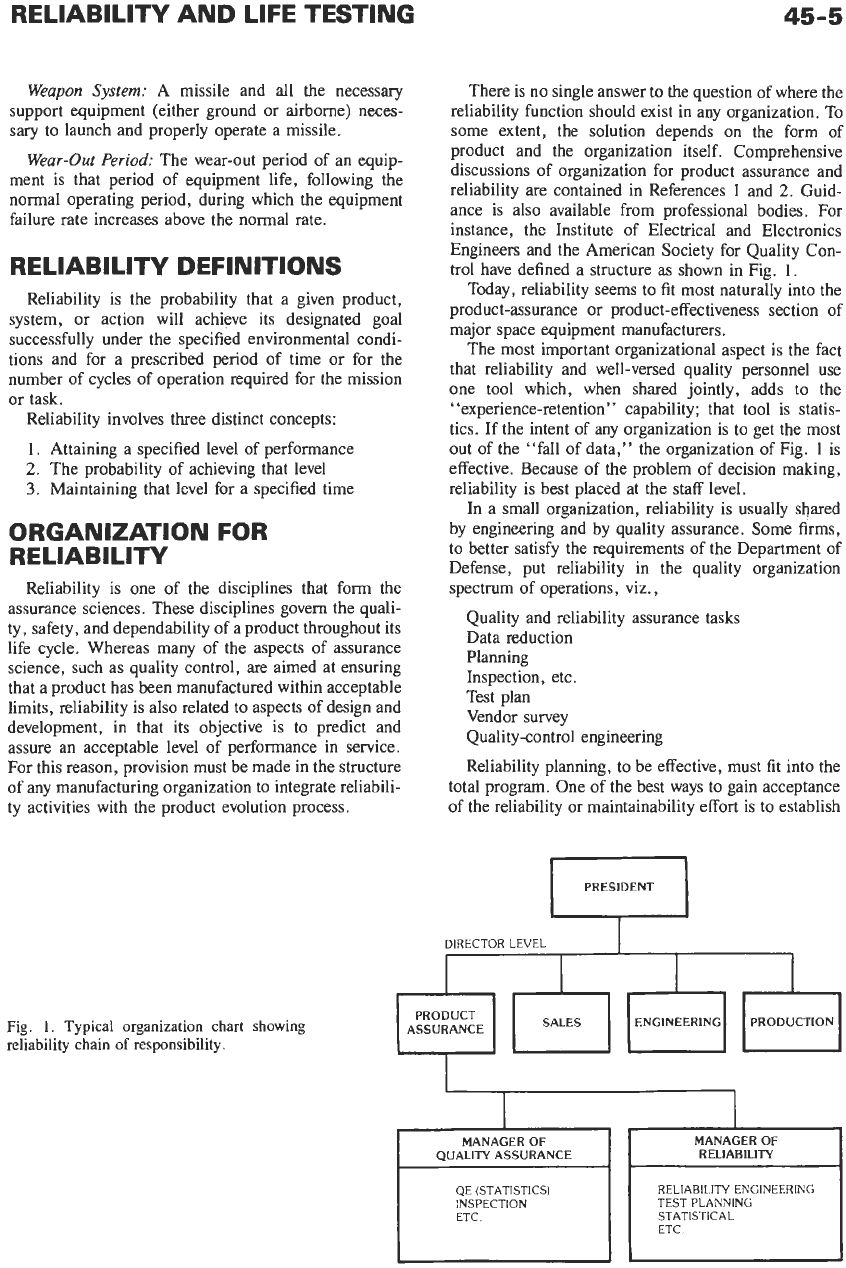
RELIABILITY
AND
LIFE TESTING
45-5
Weapon System:
A missile and all the necessary
support equipment (either ground or airborne) neces-
sary to launch and properly operate a missile.
Wear-out Period:
The wear-out period of an equip-
ment is that period of equipment life, following the
normal operating period, during which the equipment
failure rate increases above the normal rate.
RELIABILITY DEFINITIONS
Reliability is the probability that a given product,
system, or action will achieve its designated goal
successfully under the specified environmental condi-
tions and for a prescribed period of time or for the
number of cycles of operation required for the mission
or task.
Reliability involves three distinct concepts:
1.
Attaining a specified level of performance
2.
The probability of achieving that level
3.
Maintaining that level for a specified time
ORGANIZATION FOR
RELIABILITY
Reliability
is
one of the disciplines that form the
assurance sciences. These disciplines govern the quali-
ty, safety, and dependability of a product throughout its
life cycle. Whereas many of the aspects
of
assurance
science, such as quality control,
are
aimed at ensuring
that a product has been manufactured within acceptable
limits, reliability is also related to aspects of design and
development, in that its objective is to predict and
assure an acceptable level of performance in service.
For this reason, provision must be made in the structure
of any manufacturing organization to integrate reliabili-
ty activities with the product evolution process.
There is no single answer to the question of where the
reliability function should exist in any organization. To
some extent, the solution depends on the form of
product and the organization itself. Comprehensive
discussions of organization for product assurance and
reliability are contained in References
1
and
2.
Guid-
ance is also available from professional bodies. For
instance, the Institute of Electrical and Electronics
Engineers and the American Society for Quality Con-
trol have defined a structure as shown in Fig.
1.
Today, reliability seems to fit most naturally into the
product-assurance or product-effectiveness section of
major space equipment manufacturers.
The most important organizational aspect is the fact
that reliability and well-versed quality personnel use
one tool which, when shared jointly, adds to the
“experience-retention” capability; that tool is statis-
tics. If the intent of any organization is to get the most
out
of the “fall of data,” the organization of Fig.
1
is
effective. Because of the problem of decision making,
reliability is best placed at the staff level.
In a small organization, reliability
is
usually shared
by engineering and by quality assurance. Some firms,
to better satisfy the requirements of the Department of
Defense, put reliability in the quality organization
spectrum of operations, viz.,
Quality and reliability assurance tasks
Data reduction
Planning
Inspection, etc.
Test plan
Vendor survey
Quality-control engineering
Reliability planning, to be effective, must fit into the
total program. One of the best ways to gain acceptance
of the reliability or maintainability effort is to establish
I
PRESIDENT
I
DIRECTOR LEVEL
I
Fig.
1.
Typical organization chart showing
reliability chain
of
responsibility.
++lfl+l
ENGINEERING PRODUCTION
MANAGER
OF
MANAGER
OF
RELIABILITY ENGINEERINC
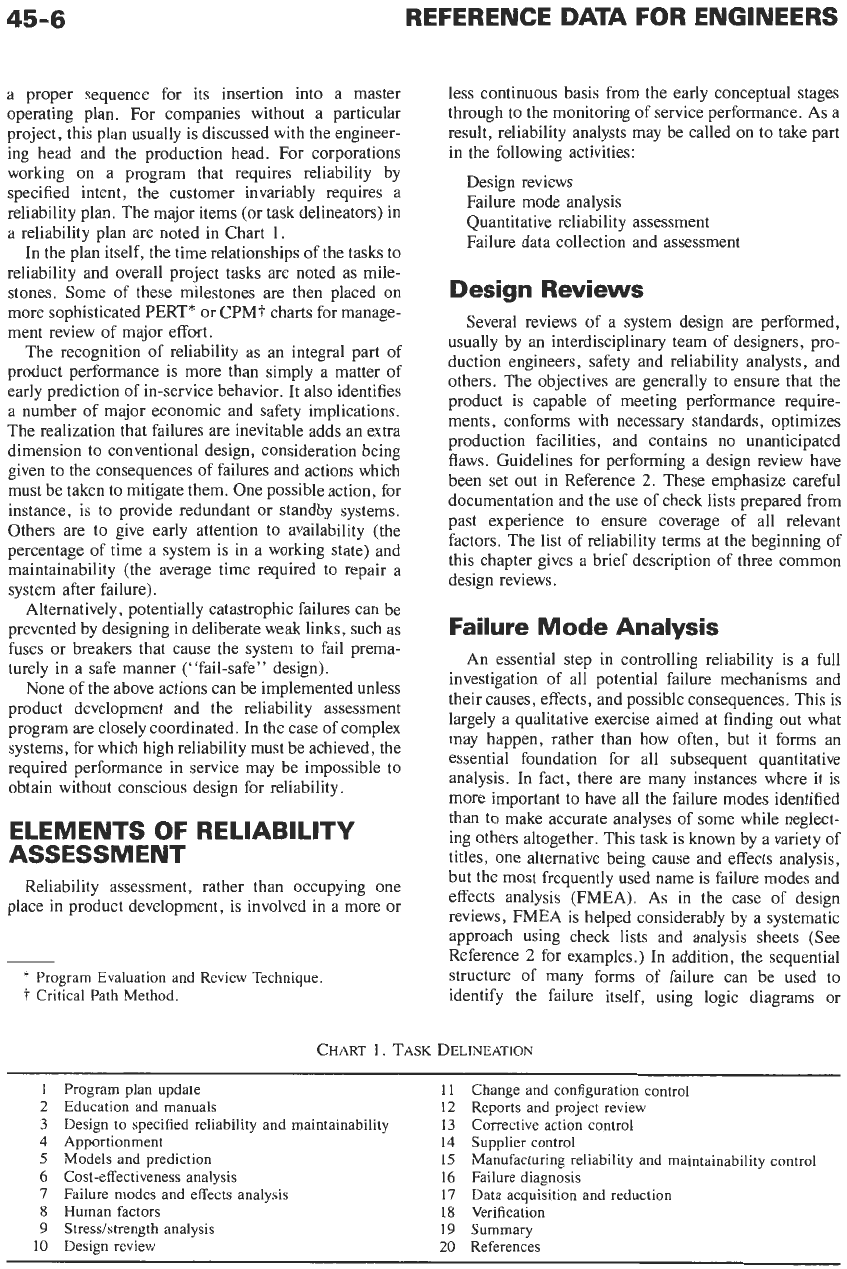
45-6
REFERENCE DATA FOR ENGINEERS
a proper sequence for its insertion into a master
operating plan. For companies without a particular
project, this plan usually is discussed with the engineer-
ing head and the production head. For corporations
working on a program that requires reliability by
specified intent, the customer invariably requires a
reliability plan. The major items (or task delineators) in
a reliability plan are noted in Chart
1.
In the plan itself, the time relationships of the tasks to
reliability and overall project tasks are noted as mile-
stones. Some of these milestones are then placed
on
more sophisticated PERT* or CPM? charts for manage-
ment review of major effort.
The recognition of reliability as an integral part of
product performance is more than simply a matter of
early prediction of in-service behavior. It also identifies
a number of major economic and safety implications.
The realization that failures are inevitable adds an extra
dimension to conventional design, consideration being
given to the consequences of failures and actions which
must be taken to mitigate them. One possible action, for
instance, is
to
provide redundant or standby systems.
Others are to give early attention to availability (the
percentage of time a system is in a working state) and
maintainability (the average time required to repair a
system after failure).
Alternatively, potentially catastrophic failures can be
prevented by designing in deliberate weak links, such as
fuses or breakers that cause the system to fail prema-
turely in a safe manner (“fail-safe” design).
None of the above actions can be implemented unless
product development and the reliability assessment
program are closely coordinated. In the case of complex
systems, for which high reliability must be achieved, the
required performance in service may be impossible to
obtain without conscious design for reliability.
ELEMENTS OF RELIABILITY
ASSESSMENT
Reliability assessment, rather than occupying one
place in product development, is involved in a more or
*
Program Evaluation and Review Technique.
‘f
Critical Path Method.
less continuous basis from the early conceptual stages
through to the monitoring of service performance. As a
result, reliability analysts may be called on to take part
in the following activities:
Design reviews
Failure mode analysis
Quantitative reliability assessment
Failure data collection and assessment
Design Reviews
Several reviews
of
a system design are performed,
usually by an interdisciplinary team of designers, pro-
duction engineers, safety and reliability analysts, and
others. The objectives are generally to ensure that the
product is capable of meeting performance require-
ments, conforms with necessary standards, optimizes
production facilities, and contains no unanticipated
flaws. Guidelines for performing a design review have
been set
out
in Reference
2.
These emphasize careful
documentation and the use of check lists prepared from
past experience to ensure coverage of all relevant
factors. The list of reliability terms at the beginning of
this chapter gives a brief description of three common
design reviews.
Failure Mode Analysis
An essential step in controlling reliability is a full
investigation of all potential failure mechanisms and
their causes, effects, and possible consequences. This is
largely a qualitative exercise aimed at finding out what
may happen, rather than how often, but it forms an
essential foundation for all subsequent quantitative
analysis. In fact, there are many instances where
it
is
more important
to
have all the failure modes identified
than to make accurate analyses of some while neglect-
ing others altogether. This task is known by a variety of
titles, one alternative being cause and effects analysis,
but the most frequently used name is failure modes and
effects analysis (FMEA). As
in
the case of design
reviews, FMEA is helped considerably by a systematic
approach using check lists and analysis sheets (See
Reference
2
for examples.) In addition, the sequential
structure of many forms of failure can be used to
identify the failure itself, using logic diagrams or
CHART
1.
TASK
DELINEATION
1
Program plan update
2
Education and manuals
3
4
Apportionment
5
Models and prediction
6
Cost-effectiveness analysis
7
8
Human factors
9
Stressistrength analysis
10
Design review
Design
to
specified reliability and maintainability
Failure modes and effects analysis
11
12
13
14
15
16
17
18
19
20
Change and configuration control
Reports and project review
Corrective action control
Supplier control
Manufacturing reliability and maintainability control
Failure diagnosis
Data acquisition and reduction
Verification
Summary
References
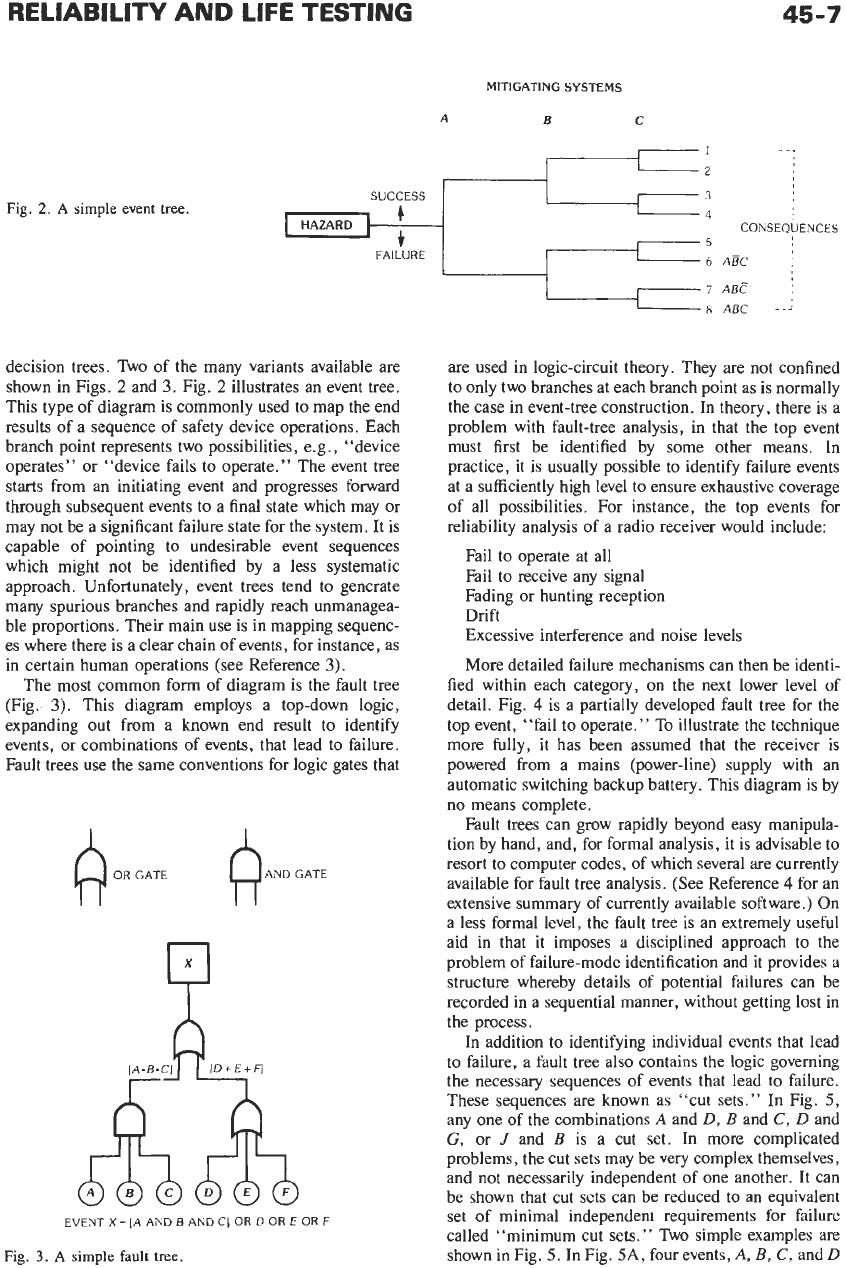
45-7
MITIGATING SYSTEMS
A
B
C
-
-,
SUCCESS
HAZARD
CONSEQUENCES
Fig. 2.
A simple
event
tree.
t
FAILURE
decision trees. Two of the many variants available are
shown in Figs.
2
and
3.
Fig.
2
illustrates an event tree.
This type of diagram is commonly used to map the end
results of a sequence of safety device operations. Each
branch point represents two possibilities, e.g., “device
operates” or “device fails to operate.” The event tree
starts from an initiating event and progresses forward
through subsequent events
to
a final state which may or
may not be a significant failure state for the system. It is
capable of pointing to undesirable event sequences
which might not be identified by a less systematic
approach. Unfortunately, event trees tend to generate
many spurious branches and rapidly reach unmanagea-
ble proportions. Their main use is in mapping sequenc-
es where there is a clear chain of events, for instance, as
in certain human operations (see Reference
3).
The most common form of diagram is the fault tree
(Fig.
3).
This diagram employs a top-down logic,
expanding out from a known end result to identify
events, or combinations of events, that lead to failure.
Fault trees use the same conventions for logic gates that
EVENT
X=
[A
AND
B
AND
Cl
OR
D OR
E
OR
F
Fig.
3.
A
simple
fault
tree.
6
ABC
~
7
AB?
I
8
ABC
--’
are used in logic-circuit theory. They are not confined
to only two branches at each branch point as is normally
the case in event-tree construction.
In
theory, there is a
problem with fault-tree analysis, in that the top event
must first be identified by some other means. In
practice, it is usually possible
to
identify failure events
at a sufficiently high level to ensure exhaustive coverage
of all possibilities. For instance, the top events for
reliability analysis of a radio receiver would include:
Fail to operate at all
Fail to receive any signal
Fading or hunting reception
Drift
Excessive interference and noise levels
More detailed failure mechanisms can then be identi-
fied within each category, on the next lower level of
detail. Fig.
4
is a partially developed fault tree for the
top event, “fail to operate.” To illustrate the technique
more fully, it has been assumed that the receiver is
powered from a mains (power-line) supply with an
automatic switching backup battery. This diagram is by
no means complete.
Fault trees can grow rapidly beyond easy manipula-
tion by hand, and, for formal analysis, it is advisable to
resort to computer codes, of which several are currently
available for fault tree analysis. (See Reference
4
for an
extensive summary of currently available software.)
On
a less formal level, the fault tree is an extremely useful
aid in that it imposes a disciplined approach to the
problem of failure-mode identification and it provides a
structure whereby details of potential failures can be
recorded in a sequential manner, without getting lost in
the process.
In
addition to identifying individual events that lead
to failure, a fault tree also contains the logic governing
the necessary sequences of events that lead to failure.
These sequences are known as “cut sets.”
In
Fig.
5,
any one of the combinations
A
and
D,
B
and
C,
D
and
G, or
J
and
B
is a cut set.
In
more complicated
problems, the cut sets may be very complex themselves,
and not necessarily independent of one another. It can
be shown that cut sets can be reduced to an equivalent
set of minimal independent requirements for failure
called “minimum cut sets.” Two simple examples are
shown in Fig.
5.
In
Fig.
5A,
four events,
A,
B,
C,
and
D

45-8
REFERENCE
F
OPERATE
011’
SI
POWER
FAILURE
FAIL
TO
OPERATE
WIRING FAULT
OPEN
CIRCUIT
F=Q+R+S
=
L*M+N+P+H+J.B
=(A+B+C)(D+ETG)+J*B+N+P+H
=A-[D+E-
G)
B.(D+E+
G
+J)
+
C.
ID +E+
G)
+
(N+P+
H)
Fig.
4.
Fault tree for radio-receiver failure mode “fail to operate
on
demand.”
contribute to some failure event
X.
Combining these
events by the rules of Boolean logic algebra,
X
occurs if
A
and
C
or
A
and
D
or
B
and
C
or
B
and
D
occur. These
sequences are cut sets and, in this case, minimum cut
sets.
In Fig. 5B, a similar fault tree contains a common
element
B
in both branches. In this case, the top event,
Y, is only dependent on the occurrence
of
A
and
C
or
B.
Here,
B
represents an important class of failures called
“common mode” or “common cause” failures. It can
be easily seen that if
A,
B,
C,
and
D
all have similar
probabilities of occurrence,
Y
has a much higher
probability of occurrence that
X,
because it only re-
quires a single event instead of two simultaneous events.
Failure
to
identify common modes or dependencies
between different failure mechanisms is a frequent
cause of excessively optimistic reliability predictions. It
can be seen from the above simple example how fault
tree analysis can be used to avoid this problem.
Quantitative Reliability
Assessment
Quantitative reliability assessment
is
one of the most
important tasks of the reliability analyst. Reliability
quantification covers two dimensions-probability of
occurrence and magnitude of the consequence of fail-
ure. Assessment of failure consequence is probably
more the task of design. Nevertheless, it cannot be
neglected in reliability assessment, particularly when
assigning reliability targets, or allocating reliability to
subsystems. Intuitively, it seems sensible to assign a
higher reliability target to a subsystem with potentially
catastrophic failure consequences than to one that
involves only a degradation in performance.
Consequences of failure can be extremely difficult to
estimate.
In
the preliminary stages
of
development, a
useful technique is called worst-case analysis. It takes
the most pessimistic values of all parameters, regardless
of the likelihood of this occurring. In electronic cir-
cuits, for instance, all components are assumed to be at
the extreme limits of their tolerance bands, including
any drift due to environmental factors. By this proce-
dure, it is possible to identify undesirable modes of
operation that might not be considered possible other-
wise. The detection of potentially catastrophic modes
of failure is probably the most useful outcome of this
type of analysis. Regardless
of
their likelihood, failures
of this type may require designing out of the system
completely. It is only in those cases where the cost of
failure can be reasonably balanced against the cost of
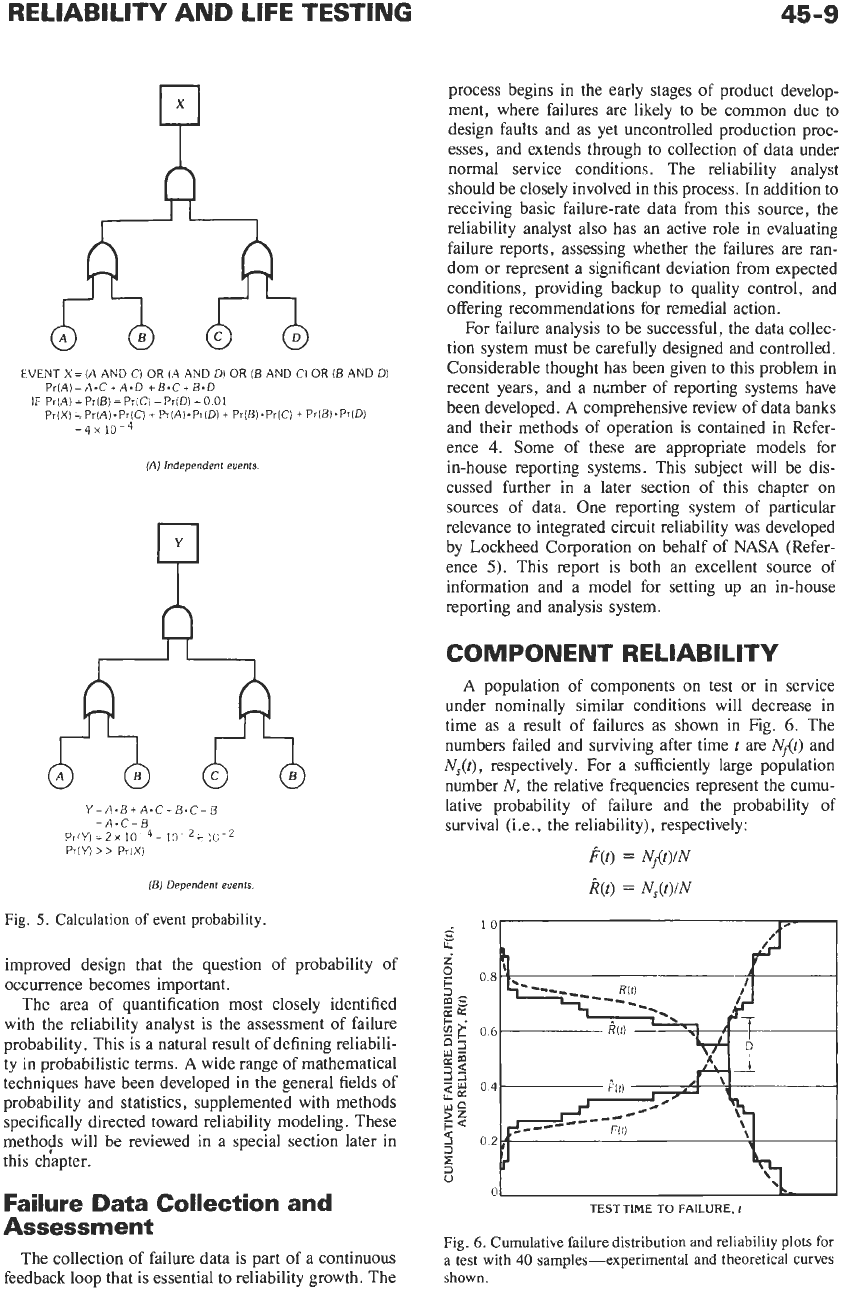
RELIABILITY AND LIFE TESTING
45-9
A
EVENT
X=
(A
AND
C)
OR
(A
AND
DI
OR
(B
AND
C)
OR
(B
AND
D)
Pr(A)=A-C+A.D
+B.C+
B.D
IF
PrlA) =Pr(B) =PIC =Pr(DI
=O
01
PrIXl +Pr(AI*Pr(C)
+Pr(AI.Pr(D)+Pr(B).PrlC)
+PrlB)*Pr(D)
=4~10-~
(A)
Independent euents.
Y=A-B+A.C+B.C-B
=A*C-B
PriM=2xlO-4+10-
2-10-2
Pr!W
>>
PrlX)
(E)
Dependent events.
Fig.
5.
Calculation of
event
probability.
improved design that the question of probability of
occurrence becomes important.
The area of quantification most closely identified
with the reliability analyst
is
the assessment of failure
probability. This is a natural result of defining reliabili-
ty in probabilistic terms.
A
wide range of mathematical
techniques have been developed in the general fields of
probability and statistics, supplemented with methods
specifically directed toward reliability modeling. These
metho$ will be reviewed in a special section later in
this chapter.
Failure Data Collection and
Assessment
The collection of failure data is part of a continuous
feedback loop that is essential to reliability growth. The
process begins in the early stages of product develop-
ment, where failures are likely to be common due to
design faults and as yet uncontrolled production proc-
esses, and extends through to collection of data under
normal service conditions. The reliability analyst
should be closely involved in this process.
In
addition to
receiving basic failure-rate data from this source, the
reliability analyst also has an active role in evaluating
failure reports, assessing whether the failures are ran-
dom or represent a significant deviation from expected
conditions, providing backup to quality control, and
offering recommendations for remedial action.
For failure analysis to be successful, the data collec-
tion system must be carefully designed and controlled.
Considerable thought has been given to this problem in
recent years, and a mmber of reporting systems have
been developed.
A
comprehensive review of data banks
and their methods of operation is contained in Refer-
ence
4.
Some of these are appropriate models for
in-house reporting systems. This subject will be dis-
cussed further in a later section of this chapter on
sources of data. One reporting system of particular
relevance to integrated circuit reliability was developed
by Lockheed Corporation on behalf of
NASA
(Refer-
ence
5).
This report is both an excellent source of
information and a model for setting up an in-house
reporting and analysis system.
COMPONENT RELIABILITY
A
population of components
on
test or
in
service
under nominally similar conditions will decrease in
time as a result of failures as shown in Fig.
6.
The
numbers failed and surviving after time
t
are
Nkt)
and
N,(t),
respectively. For a sufficiently large population
number
N,
the relative frequencies represent the cumu-
lative probability of failure and the probability
of
survival (Le., the reliability), respectively:
$(t)
=
Nht)/N
B(t)
=
N,(t)/N
TEST TIME TO FAILURE.
f
Fig.
6.
Cumulative
failure distribution
and
reliability
plots
for
a
test
with
40
samples-experimental
and
theoretical
curves
shown.
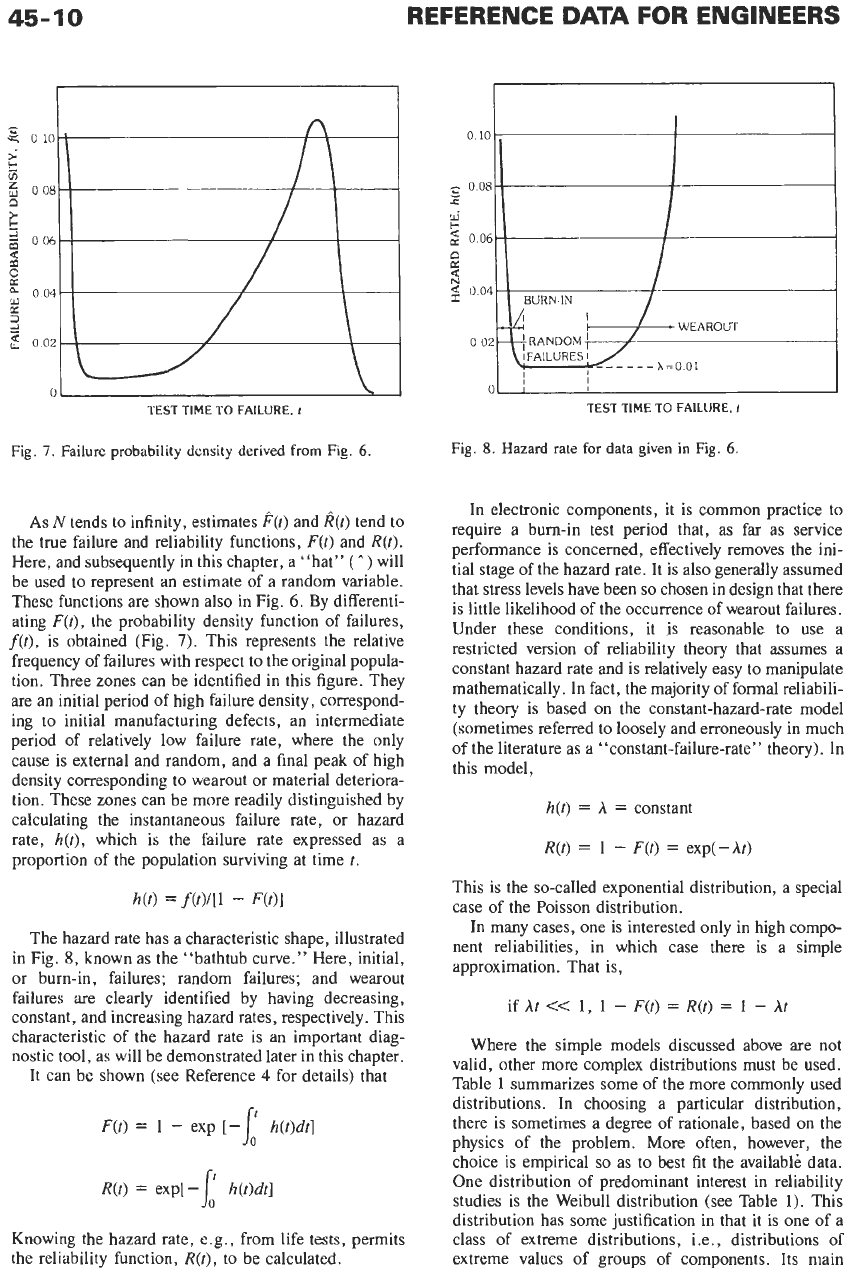
REFERENCE
DATA
FOR ENGINEERS
-
010
c
c
2
2
2
002
z
008
8
006
C
004
w
0
TEST TIME
TO
FAILURE,
f
Fig.
7.
Failure probability density derived from Fig.
6.
As
N
tends to infinity, estimates
&)
and
&)
tend to
the true failure and reliability functions,
F(t)
and
R(t).
Here, and subsequently in this chapter, a “hat”
(*)
will
be used to represent an estimate of a random variable.
These functions are shown also in Fig.
6.
By differenti-
ating
Fa),
the probability density function of failures,
f(t),
is obtained (Fig.
7).
This represents the relative
frequency of failures with respect to the original popula-
tion. Three zones can be identified in this figure. They
are an initial period of high failure density, correspond-
ing to initial manufacturing defects, an intermediate
period of relatively low failure rate, where the only
cause is external and random, and a final peak of high
density corresponding to wearout or material deteriora-
tion. These zones can be more readily distinguished by
calculating the instantaneous failure rate, or hazard
rate,
h(t),
which is the failure rate expressed as a
proportion of the population surviving at time
t.
W)
=
f(t)/[l
-
FMl
The hazard rate has a characteristic shape, illustrated
in Fig.
8,
known as the “bathtub curve.” Here, initial,
or burn-in, failures; random failures; and wearout
failures are clearly identified by having decreasing,
constant, and increasing hazard rates, respectively. This
characteristic of the hazard rate is an important diag-
nostic tool, as will be demonstrated later in this chapter.
It can be shown (see Reference
4
for details) that
Knowing the hazard rate, e.g., from life tests, permits
the reliability function,
R(t),
to be calculated.
0 10
0 08
-
s
c
ui
2
006
c1
K
2
004
0 02
TEST TIME
TO
FAILURE,
t
Fig.
8.
Hazard rate for
data
given
in
Fig.
6.
In electronic components, it is common practice to
require a burn-in test period that, as far as service
performance is concerned, effectively removes the ini-
tial stage of the hazard rate. It is also generally assumed
that stress levels have been
so
chosen in design that there
is little likelihood of the occurrence of wearout failures.
Under these conditions, it is reasonable to use a
restricted version of reliability theory that assumes a
constant hazard rate and is relatively easy to manipulate
mathematically. In fact, the majority of formal reliabili-
ty theory is based on the constant-hazard-rate model
(sometimes referred to loosely and erroneously in much
of the literature as a “constant-failure-rate” theory). In
this model,
h(t)
=
A
=
constant
R(t)
=
1
-
F(t)
=
exp(
-At)
This is the so-called exponential distribution, a special
case of the Poisson distribution.
In many cases, one is interested only in high compo-
nent reliabilities, in which case there is a simple
approximation. That is,
if
At
<<
1, 1
-
F(t)
=
R(t)
=
1
-
At
Where the simple models discussed above are not
valid, other more complex distributions must be used.
Table
1
summarizes some of the more commonly used
distributions. In choosing a particular distribution,
there is sometimes a degree of rationale, based on the
physics of the problem. More often, however, the
choice is empirical
so
as to best fit the availabk data.
One distribution of predominant interest in reliability
studies is the Weibull distribution (see Table
1).
This
distribution has some justification in that it is one of a
class of extreme distributions, Le., distributions of
extreme values of groups of components. Its main
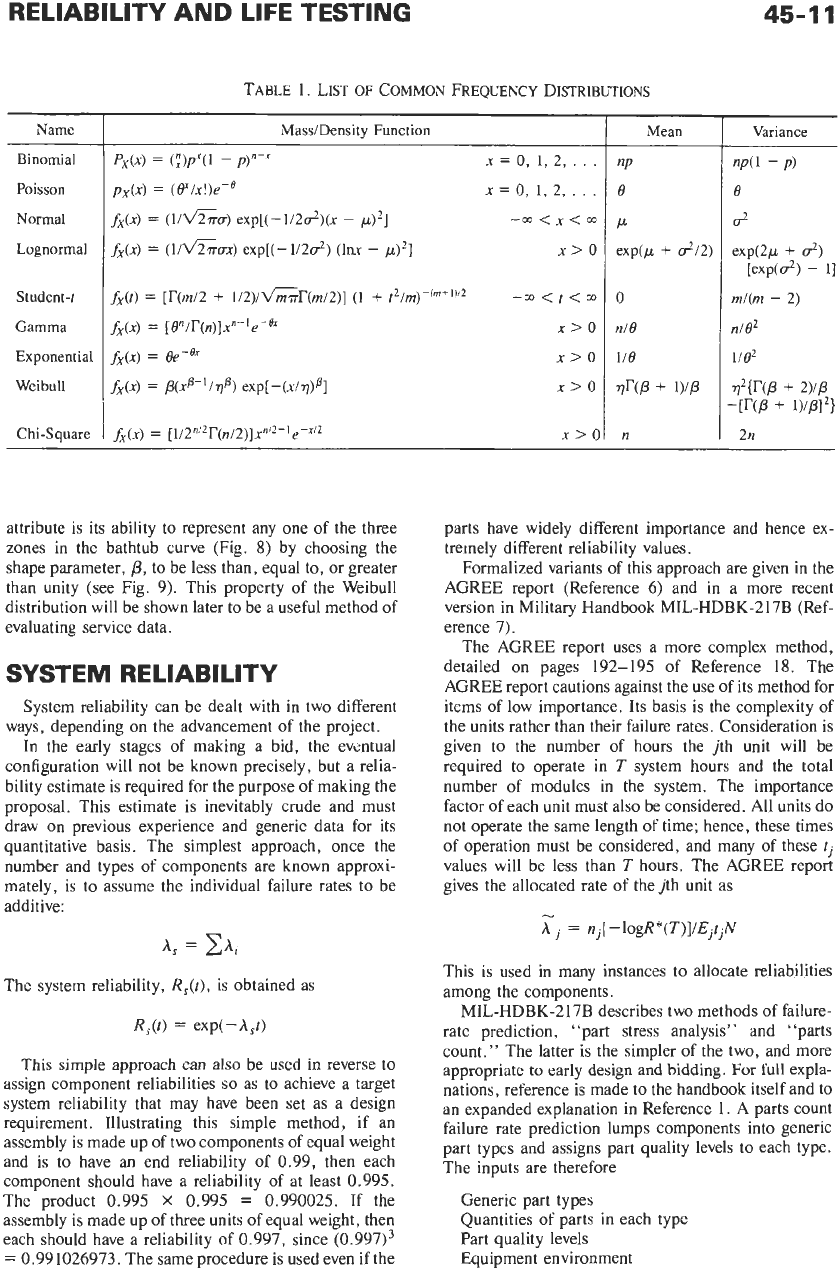
RELIABILITY AND
LIFE
TESTING
45-1
1
TABLE
1. LIST
OF
COMMON FREQUENCY DISTRIBUTIONS
Name
Binomial
Poisson
Normal
Lognormal
Student-t
Gamma
Exponential
Weibull
Chi-square
MasdDensity Function
Mean
nP
e
P
exp(p
+
22/21
n
attribute is its ability
to
represent any one of the three
zones in the bathtub curve (Fig.
8)
by choosing the
shape parameter,
p,
to
be less than, equal to, or greater
than unity (see Fig. 9). This property of the Weibull
distribution will be shown later to be a useful method of
evaluating service data.
SYSTEM RELIABILITY
System reliability can be dealt with in two different
ways, depending on the advancement of the project.
In the early stages of making a bid, the evzntual
configuration will not be known precisely, but a relia-
bility estimate is required for the purpose of making the
proposal. This estimate is inevitably crude and must
draw on previous experience and generic data for its
quantitative basis. The simplest approach, once the
number and types of components are known approxi-
mately, is to assume the individual failure rates to be
additive:
The system reliability,
R,(t),
is obtained as
R,(t)
=
exp(-A$)
This
simple approach can also be used
in
reverse to
assign component reliabilities
so
as to achieve a target
system reliability that may have been set as a design
requirement.
Illustrating this simple method, if an
assembly is made up of two components of equal weight
and is to have an end reliability of 0.99, then each
component should have a reliability of at least 0.995.
The product 0.995
X
0.995
=
0.990025. If the
assembly
is
made up of three units of equal weight, then
each should have a reliability of 0.997, since (0.997)3
=
0.991026973, The same procedure is used even if the
parts have widely different importance and hence ex-
tremely different reliability values.
Formalized variants of this approach are given in the
AGREE report (Reference
6)
and in a more recent
version in Military Handbook MIL-HDBK-217B (Ref-
erence 7).
The AGREE report uses a more complex method,
detailed on pages 192-195 of Reference 18. The
AGREE report cautions against the use of its method for
items of low importance. Its basis is the complexity of
the units rather than their failure rates. Consideration is
given to the number of hours the jth unit will be
required to operate in
T
system hours and the total
number of modules in the system. The importance
factor of each unit must also be considered. All units do
not operate the same length of time; hence, these times
of operation must be considered, and many of these
ti
values will be less than
T
hours. The AGREE report
gives the allocated rate of the jth unit as
-
A
=
nj[-logR*(T)]/EjtjN
This is used in many instances
to
allocate reliabilities
among the components.
MIL-HDBK-2 17B describes two methods of failure-
rate prediction, "part stress analysis" and "parts
count." The latter is the simpler of the two, and more
appropriate to early design and bidding.
For
full
expla-
nations, reference is made to the handbook itself and to
an expanded explanation in Reference 1. A parts count
failure rate prediction lumps components into generic
part types and assigns part quality levels to each type.
The inputs are therefore
Generic part types
Quantities of parts in each type
Part quality levels
Equipment environment
